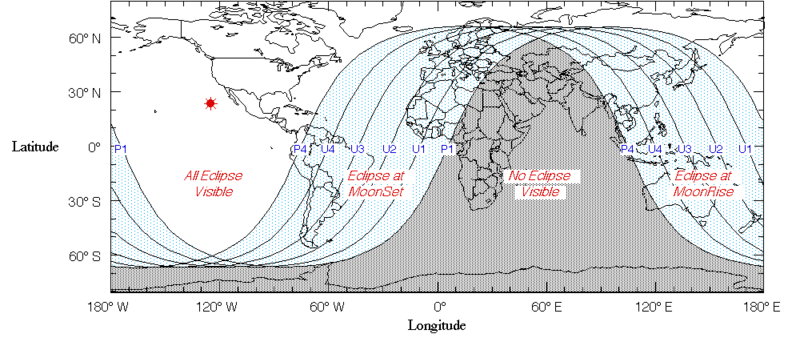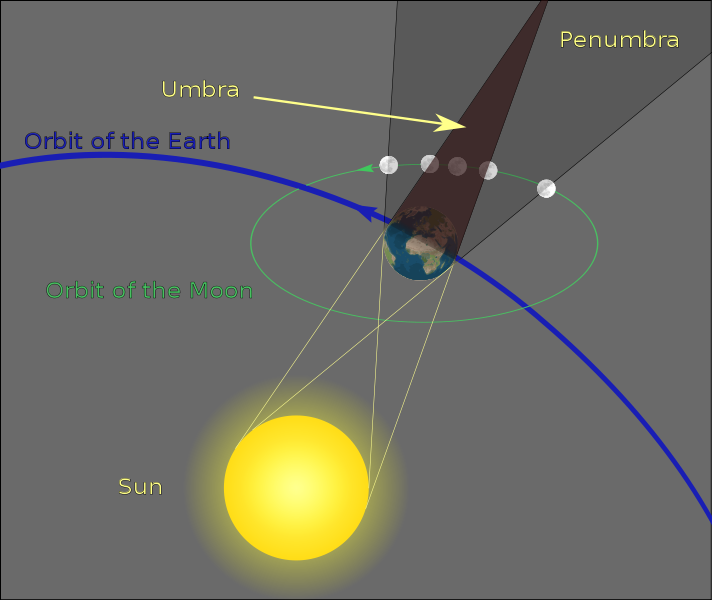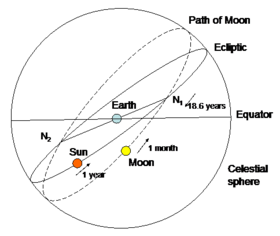More Eclipses
(10 pm. – promoted by ek hornbeck)
|
The first total lunar eclipse in nearly three years will be visible this
Monday/Tuesday over North and South America beginning at midnight on the
21st of December, 2010.
From the Wikipedia
article

Times of over North America
| Event |
PST
(-8 UTC) |
MST
(-7 UTC) |
CST
(-6 UTC) |
EST
(-5 UTC) |
| Start penumbral (P1) |
9:27 pm (*) |
10:27 pm (*) |
11:27 pm (*) |
12:27 am |
| Start umbral (U1) |
10:32 pm (*) |
11:32 pm (*) |
12:32 am |
1:32 am |
| Start total (U2) |
11:40 pm (*) |
12:40 am |
1:40 am |
2:40 am |
| Greatest eclipse |
12:17 am |
1:17 am |
2:17 am |
3:17 am |
| End total (U3) |
12:53 am |
1:53 am |
2:53 am |
3:53 am |
| End umbra (U4) |
2:02 am |
3:02 am |
4:02 am |
5:02 am |
| End penumbral (P4) |
3:06 am |
4:06 am |
5:06 am |
6:06 am |
(*) before midnight on Monday night,
December 20 |
|
| This graphic presents how a lunar eclipse occurs. |
 |
The Moon’s orbit is slightly canted with respect to
the plane of the ecliptic (the plane in which the Earth orbits the Sun)
and therefore crosses that plane twice a month. |
 |
|
At the points where the full Moon crosses the ecliptic
a lunar eclipse can occur. Like solar eclipses there may be between 2 and
5 lunar eclipses per year.
There are three types of lunar eclipses. Penumbral, partial, and
selenelion (selenehelion).
A penumbral eclipse occurs when the Moon passes through the Earth’s
penumbra. The penumbra causes a subtle darkening of the Moon’s surface. A
special type of penumbral eclipse is a total penumbral eclipse, during
which the Moon lies exclusively within the Earth’s penumbra. Total
penumbral eclipses are rare, and when these occur, that portion of the
Moon which is closest to the umbra can appear somewhat darker than the
rest of the Moon.
A partial lunar eclipse occurs when only a portion of the Moon
enters the umbra. When the Moon travels completely into the Earth’s umbra,
one observes a total lunar eclipse. The Moon’s speed through the shadow is
about one kilometer per second (2,300 mph), and totality may last up to
nearly 107 minutes. Nevertheless, the total time between the Moon’s first
and last contact with the shadow is much longer, and could last up to 3.8
hours.wiki: [1] The relative distance of the Moon from the
Earth at the time of an eclipse can affect the eclipse’s duration. In
particular, when the Moon is near its apogee, the farthest point from the
Earth in its orbit, its orbital speed is the slowest. The diameter of the
umbra does not decrease much with distance. Thus, a totally eclipsed Moon
occurring near apogee will lengthen the duration of totality.
A selenelion or selenehelion occurs when both the Sun and
the eclipsed Moon can be observed at the same time. This can only happen
just before sunset or just after sunrise, and both bodies will appear just
above the horizon at nearly opposite points in the sky. This arrangement
has led to the phenomenon being referred to as a horizontal eclipse. It
happens during every lunar eclipse at all those places on the Earth where
it is sunrise or sunset at the time. Indeed, the reddened light that
reaches the Moon comes from all the simultaneous sunrises and sunsets on
the Earth. Although the Moon is in the Earth’s geometrical shadow, the Sun
and the eclipsed Moon can appear in the sky at the same time because the
refraction of light through the Earth’s atmosphere causes objects near the
horizon to appear higher in the sky than their true geometric position.wiki:
[2]Wikipedia
|
Unfortunately, the weather seems to be taking a Republican bent and will
not cooperate over the 20th/21st.
Again thanks for your time. I look forward to your comments and critiques
below.
Comments have been disabled.




13 comments
Skip to comment form
Author
Dec. 20 10 00 pm.
When diary will be promoted: Mon Dec 20, 2010 at 22:00:00 PM EST
It is the second time this year that there will be a full moon at the change of season.
For those who can’t watch the eclipse because of cloud cover. A Twitter friend, watergatesummer, has provided a link to the this website:
2010 Lunar Eclipse Webcast
I’ll try again in half an hour.
No Moon visible.
But a noticeable lack of Moon.
About half the Moon is missing.
I’m hoping it will clear enough so I can see the color.
Predictions are orange.
Can’t see nothing, but it might just be clouds.
I’ll hang for about another hour on the 15s.
But no moon either.
an absence of seeing the Moon when you should be seeing it as a successful observation, then I am definitely successful.
I can faithfully attest that if you were standing in my back yard you wouldn’t see the Moon at all.